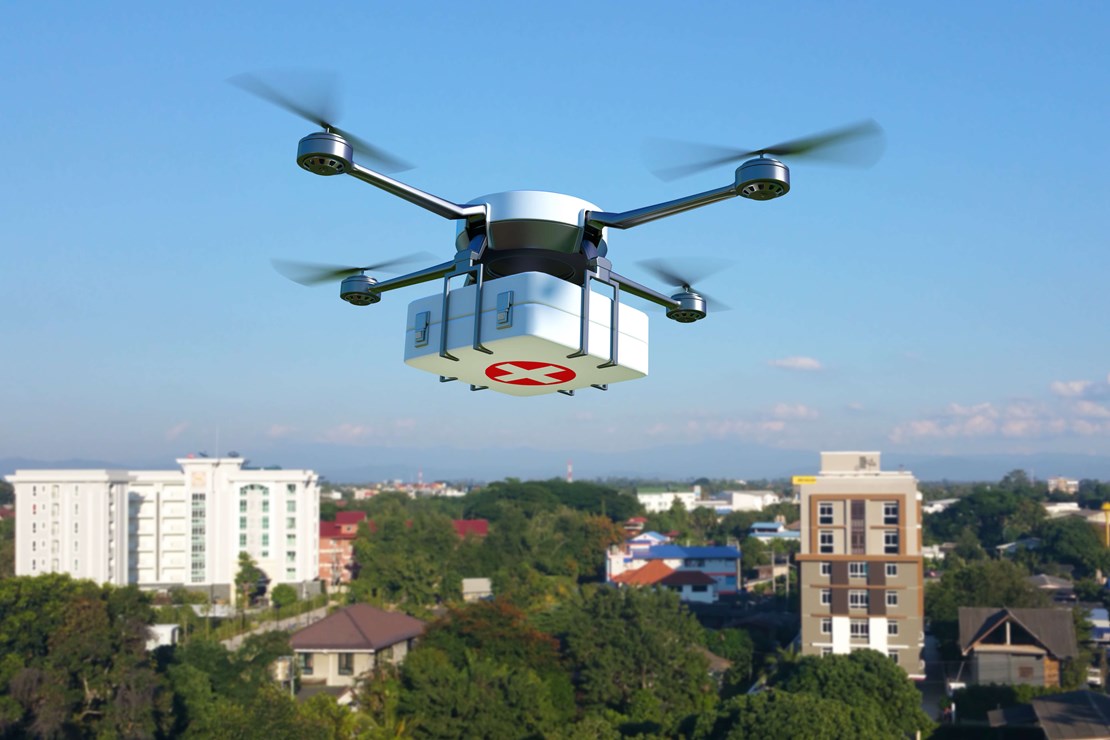Drones are already in use across the UK to provide an effective solution to a range of logistical challenges. In this article, Amy Hollis, from technological innovation firm, Neuron, shares how this technology is also being applied within healthcare as part of an efficient, safe, contact-free delivery method.
Drones (or Unmanned Aerial Vehicles - UAVs) are changing the way healthcare and businesses operate across the world. Drones can be built to carry a payload or deliver packages to their designated location, and their contents can be anything from medical supplies to telediagnostics that support remote healthcare delivery.
With congested transport networks, rural communities where fast access to emergency medicine, diagnostics and regular medical deliveries can be a challenge, and with a desire to decrease carbon emissions globally, drones provide an effective solution to logistics planning within healthcare. They offer a real option for organisations who want to increase efficiency and provide consistent, faster results for their clients.
Here in the UK, proof-of-concept trials are already underway to show how healthcare logistics can be streamlined using these automated flights.
Connecting care facilities
Through its MediDrone project, Neuron is working with a number of healthcare organisations and infrastructure suppliers to trial drone-based solutions. In an effort to battle the growing challenge around antimicrobial resistance, we have been working with NHS trusts to enable fast and accurate diagnosis of Urinary Tract Infections in rural communities, where testing facilities may be hundreds of miles away from the local GP surgery.
In some hospital trusts we are working on intra-hospital deliveries to increase efficiency and productivity. Where trusts are based over multiple sites, logistical challenges can exist which mean that getting samples to testing, delivering results or sending prescriptions can take time. This can increase the amount of time that patients remain in hospital, slow down diagnoses and increase bed occupancy. By utilising automated drone deliveries within hospital buildings, we can free up capacity for staff, speed up the process of medical diagnostics and improve the care pathway.
Another key use is connecting pharmacies to explore the possibilities of prescription drop-off with local care homes. During COVID-19 the need for a contact-free mechanism for medication delivery has become increasingly apparent. This doesn’t only apply to pandemics, but equally during winter, when reducing contact can save the lives of those susceptible to the variety of illnesses that present themselves at this time.
Delivering COVID-19 test kits to ships
Utilising trial flights, MediDrone has demonstrated the delivery of COVID-19 test kits from shore-to-ship in Montrose. Montrose is a coastal town in the Angus region of Scotland, with a busy free port. Each day pilot boats perform visual inspections of the coastline and, if a vessel off the coast needs emergency assistance, these will be deployed to deliver supplies. This exercise can be extremely dangerous and detracts from the pre-planned activities taking place on a port. During a pandemic, there is an increased need to be able to respond to shipping requirements while minimising contact.
This trial successfully demonstrated how drones can revolutionise shipping and offshore activities, and can be invaluable during a healthcare crisis, but crucially showed how keeping the skies safe is essential to enabling these types of new innovation.
Drones provide a quick, safe, contact-free delivery mechanism and while the COVID-19 pandemic has given additional focus to the possibilities where drone deliveries are concerned, their application in medical logistics goes far beyond a crisis situation.
Working with the Medical Devices division of NIHR - we have a survey that we would encourage every reader to complete, which will help build a wider understanding of how drones could fit into the healthcare infrastructure.
How Neuron’s technology makes this possible
Currently the law in the UK means that, aside from special circumstances, a drone can only be flown when the pilot can see it, meaning the drone couldn’t travel over long distances. However, Neuron is providing a solution to this problem, by offering software which enables airspace users to safely avoid each other. We are actively seeking funding opportunities to develop these trial sites while gathering case studies on the medical applications of this drone technology. Building in the infrastructure to support this safer airspace is crucial to it’s long-term success and with Neuron’s technology we will be able to utilise the skies to improve healthcare worldwide.

